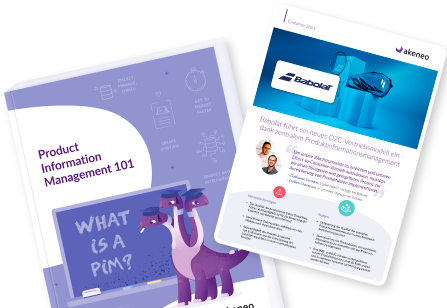Jul 10, 2023
4 min to read
Are your digital assets scattered, causing chaos and wasting valuable time? Say goodbye to inefficiencies and hello to seamless organization and productivity. From centralized data management to automated workflows, we dive into everything you need to unlock the true potential of your digital assets.

In today’s fast-paced digital world, where captivating visuals and engaging content rule the online realm, one thing is clear: digital assets are the lifeblood of effective communication and brand success. Whether it’s striking images, compelling videos, or informative product data, the proper management of these digital assets is crucial to staying ahead of the competition.
But managing all that digital data is no easy feat, especially if you don’t have the tools or technology in place to support a streamlined workflow that not only organizes, secures, and delivers your digital assets to various channels, but also communicates seamlessly with your other technology.
Implementing a Digital Asset Management (DAM) tool is a great way to kickstart this process, but diving head-first into any random software solution you find is a recipe for headaches, miscommunication, messy data, and ultimately a poor customer experience.
Let’s dive into the top 10 best practices you can do both before DAM implementation and after.
Before diving into DAM implementation, it is crucial to assess your current digital asset inventory. Conduct a comprehensive audit to identify inaccuracies, outdated files, and any gaps in your asset library. This process will enable you to clean up your digital assets, remove redundant files, and ensure that only relevant and up-to-date materials are included in your DAM system.
One common challenge faced by organizations is scattered product information across various platforms, tools, and spreadsheets. To establish a solid foundation for DAM implementation, centralize your product data into a single system of record, like a Product Information Management (PIM) system, that can communicate seamlessly with your new DAM tool. By doing so, you can eliminate silos, reduce duplication, and have a holistic view of your digital assets.
Implementing a DAM system without a clear objective in mind can lead to confusion and inefficiencies. Take the time to define a strategic goal that aligns with your business objectives. Whether it is improving collaboration, accelerating time-to-market, or enhancing brand consistency, clearly identifying your objectives will guide your decision-making process and ensure that your DAM system meets your organization’s unique needs.
Successful DAM implementation requires a team effort. Identify key stakeholders within your organization who will be involved in the process. Assign clear roles and responsibilities to each team member to ensure accountability and smooth collaboration. Additionally, you should be able to implement granular user access management to control who can access, edit, and distribute specific assets. This not only ensures data security but also protects intellectual property and maintains compliance with privacy regulations, all while still providing key stakeholders with the digital assets they need, when they need it.
To maximize the benefits of your DAM system, identify the tools and applications that need to integrate seamlessly with it. Whether it’s your content management system, eCommerce platform, PIM, or Enterprise Resource Planning (ERP) tool, ensure that your DAM system can integrate with these essential tools. This integration will enable you to leverage your digital assets efficiently across multiple channels and touchpoints, ensuring a consistent and compelling product experience no matter where your customers research and discover you.
Consistency is key when it comes to organizing and searching for digital assets. Create standardized naming conventions for your files to ensure clarity and ease of identification. By adopting a consistent naming structure, you can avoid confusion, prevent duplicate files, and improve the overall efficiency of your DAM system.
Metadata provides vital context and information about your digital assets, and can include information such as file descriptions, keywords, categories, and usage rights. Develop a robust metadata schema and apply it consistently across your asset library. By implementing metadata standards, you can enhance searchability, improve asset categorization, and facilitate the efficient retrieval of assets when needed.
Automation is a game-changer when it comes to optimizing your DAM workflows. Leverage the capabilities of your DAM system to create automatic workflows that streamline operations. For example, you can set up workflows for file approvals, metadata tagging, or asset distribution. These automated processes save time, reduce human error, and ensure that assets follow the correct approval and distribution channels. And with new technologies like Artificial Intelligence (AI) becoming more and more advanced and accessible, automating mundane or repetitive tasks within your DAM system can improve operational efficiency and ensure that your employees are focusing on high-value work.
To fully harness the power of your DAM system, invest in comprehensive training and ongoing support for your users. Educate them on how to effectively use the DAM system and familiarize them with best practices for uploading, tagging, and searching for assets. By empowering your users with the necessary skills and knowledge, you can improve their efficiency, increase adoption rates, and maximize the value derived from your DAM system.
Implementing a DAM system is not a one-time task; it requires continuous maintenance and optimization. Regularly audit and assess the performance and usage of your DAM system. Seek feedback from users on the product experience, identify areas for improvement, and implement necessary updates or modifications to enhance efficiency and user satisfaction. Additionally, regularly review and maintain file organization to accommodate changing requirements and ensure that your DAM system remains scalable and adaptable to your evolving needs.
Implementing DAM best practices is crucial for any organization that wants to effectively manage its digital assets and optimize workflows. By conducting an initial audit, centralizing data, defining clear goals, assigning roles, and implementing user access management, you can lay a solid foundation for your DAM system. Once implemented, focus on standardized naming, metadata standards, automation, user training, and ongoing maintenance to ensure optimal efficiency and success. By following these best practices, you can unlock the full potential of your digital assets, streamline your operations, and gain a competitive edge in the digital landscape.
Want to learn more about how Akeneo technology can help support your DAM implementation by creating a central source of record and enable your team to provide stronger product experiences? Reach out to an Akeneo expert today.
Discover how Akeneo technology can support your DAM implementation, and more. Start your journey towards better product experiences today.

Sign up for our newsletter and stay ahead of the curve on everything you need to know about product information management, product experience management and how to unlock growth for your organization.
